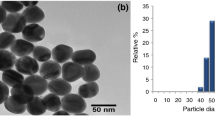The subject of the present study is a tubular fractionating tower in which the heat exchange pipes and the intertubular space together function as contact devices, while the process of fractionation itself occurs in the film mode; the tubular space fulfills the functions of a stripping section, while the intertubular space serves as a rectifying section and condenser for use in the formation of distillate. As a result of mass transfer, the steam phase is enriched with low-boiling components and the liquid phase with high-boiling components. The study is designed to develop methods of calculating and simulating processes in a fractionating tower with integrated heat exchange. Through the use of the results of the study, the energy consumption and metal content of the equipment may both be reduced.






Similar content being viewed by others
References
V. B. Kogan and M. A. Kharisov, Equipment for Vacuum Separation of Mixtures, Mashinostroenie, Leningrad (1976).
M. Nakaiwa and T. Ohmori, “Process of intensification for energy savings through concept of ‘detuning’ from ideal state,” Transl. from Synthesiology, 2, No. 1, 51–59 (2009).
M. Nakaiwa, K. Huang, A. Endo, et al., “Internally heat-integrated distillation towers,” IChemE, 81, No. 1, 162–177 (2003).
I. L. Leytes, M. Kh. Sosna, and V. P. Semenov, Theory and Applications of Chemical Energy Technology, Khimiya, Moscow (1988).
N. N. Istomin and M. V. Klykov, Patent 2144412 RF, IPC4 B 01 D 22, “A refining stripper,” No. 98112555/12, Byull., No. 2 (2000).
M. V. Klykov and E. F. Timergazin, “Refining film strippers in resource-conservation technologies,” in: Chemistry and Chemical Technologies – Present and Future: Proc. Int. Sci. Conf., Sterlitamak (1999), pp. 108–111.
Yu. I. Dytnerskii, Fundamental Processes and Apparatuses in Chemical Technology: Design Manual, Khimiya, Moscow (1983).
L. I. Zhivaykin, “On a technique for calculating the hydraulic resistance of film apparatuses,” Teor. Osn. Khim. Tekhnol., 3, No. 1, 145–147 (1969).
T. L. Kaler, V. M. Olevskii, and M. A. Dmitriev, “Hydrodynamics of gas flow in a tubular film tower in counterflow of phases,” Teor. Osn. Khim. Tekhnol., 5, No. 2, 259–266 (1971).
V. A. Malyusov, S. K. Myasnikov, and N. N. Kulov, “Hydraulic resistance in movement through a pipe with irrigated wall,” Teor. Osn. Khim. Tekhnol., 7, No. 1, 524–533 (1973).
A. A. Treiman, V. Ya. Mikhall, and E. K. Siyrde, “Flooding under the condition of a moderate vacuum,” Tr. Talmen. Politekh. Inst. Ser. A, No. 283, 47–54 (1969).
Author information
Authors and Affiliations
Corresponding author
Additional information
Translated from Khimicheskoe i Neftegazovoe Mashinostroenie, No. 12, pp. 19–22, December, 2016.
Rights and permissions
About this article
Cite this article
Klykov, M.V., Surkov, G.S. Fractionating Tower with Integrated Heat Transfer. Chem Petrol Eng 52, 827–833 (2017). https://doi.org/10.1007/s10556-017-0278-x
Published:
Issue Date:
DOI: https://doi.org/10.1007/s10556-017-0278-x




